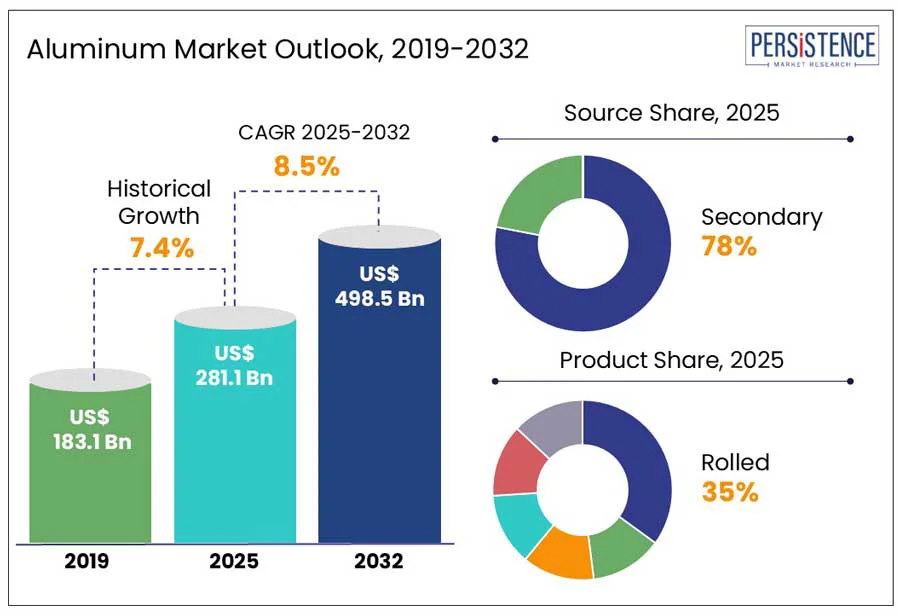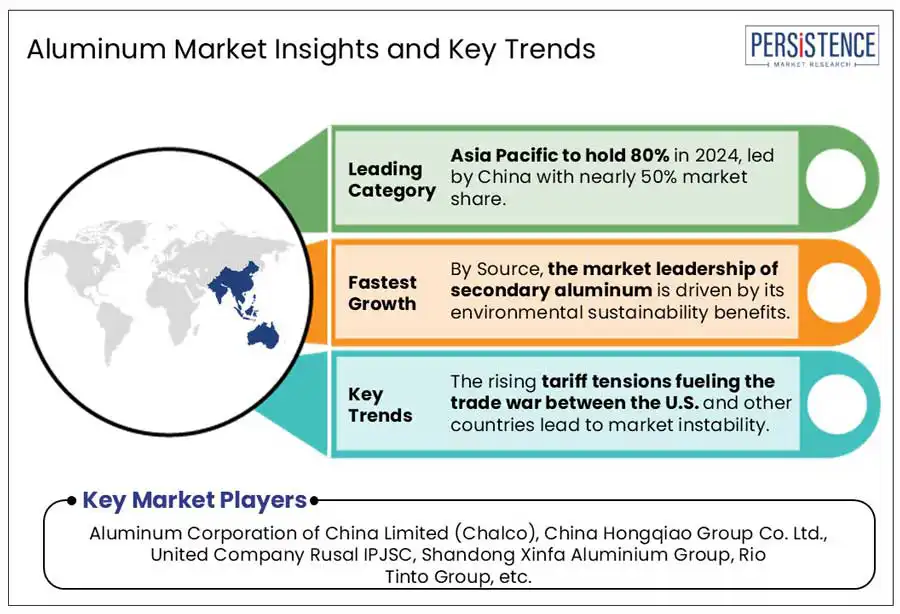ID: PMRREP33569| 189 Pages | 20 May 2025 | Format: PDF, Excel, PPT* | Chemicals and Materials

The global aluminum market is projected to rise from US$ 281.1 Bn in 2025 to US$ 498.5 Bn at a CAGR of 8.5% by 2032. Aluminum is driving the attention of several industries due to its versatile properties. The growing demand for electric vehicles (EVs) is driving the aluminum market. It is a material of choice over iron and steel as it effectively addresses the major automotive challenges such as lightweight, CO2 emissions, and fuel efficiency. A study by Shapes, the aluminum knowledge hub, indicates that replacing one kilogram of steel with aluminum in a vehicle can cut CO? emissions by 19 kilograms over its lifetime.

Key Industry Highlights:
|
Global Market Attribute |
Key Insights |
|
Aluminum Market Size (2025E) |
US$ 281.1 Bn |
|
Projected Market Value (2032F) |
US$ 498.5 Bn |
|
Global Market Growth Rate (CAGR 2025 to 2032) |
8.5% |
|
Historical Market Growth Rate (CAGR 2019 to 2024) |
7.4% |
The automotive industry is constantly evolving with advancements in technology. The International Energy Agency (IEA) study indicates that electric vehicle sales are expected to surpass 20% of total car sales by 2024. This growth is driving manufacturers to focus on reducing vehicle weight, with an emphasis on utilizing aluminum replacing steel to improve fuel efficiency and minimize CO2 emissions. For instance, Emirates Global Aluminium has been supplying aluminum to BMW since 2013. From 2023, the group supplied the solar-powered recycled aluminum ‘CelestiAL-R’ to BMW. The Aluminum Association's study reveals that replacing steel with aluminum can reduce vehicle weight by over 1 kilogram, improving performance and efficiency. The demand for the aluminum market is driven by its solutions for vehicle weight and fuel efficiency.
The rising tension between global superpowers such as United States, Asian and European countries hinder the aluminum supply chain. The United States is demanding to increase the tariffs on the goods imported from the countries, such as China, Canada, and Mexico, in response to the illegal immigration and drugs issues in the U.S. caused by the above countries. The tariff war between these countries lead to the instability of the market. On February 1, 2025, the U.S. implemented a 25% additional tariffs on imports from Canada and Mexico and a 10% additional tariff on imports from China. The geopolitical instability and the trade war hinders the aluminum market on global scale.
The growing demand for aluminum presents challenges due to rising carbon emissions and stricter global regulations on greenhouse gases. The energy-intensive production process relies heavily on coal and fossil fuels, leading to significant carbon emissions. According to the study from CEEW, the Indian aluminum industry emits 20.88 tonnes of CO2 per tonne of aluminum. This includes the emissions due to direct fuel use, emissions associated with the electricity consumed in the process, and the emissions generated due to the nature of the process itself. The strict regulations from the governments drive the manufacturers the focus on alternate sources for the energy supply.
The growing emphasis on sustainability in construction presents a significant opportunity for aluminum manufacturers. As the demand for greener buildings increases, aluminum's lightweight, corrosion-resistant, and recyclable properties make it an attractive alternative to traditional materials like steel. Recent data from the Aluminum Association indicates that the U.S. building and construction market consumes around 2.5 billion pounds of aluminum annually, primarily for non-residential applications such as windows and cladding. Aluminum provides effective thermal management, keeping buildings cool in summer and warm in winter. The growing construction industry in emerging economies such as India and China offers significant investment opportunities.
Secondary aluminum, or recycled aluminum, can be reused indefinitely through a closed-loop process, making it both environmentally and economically sustainable. Recycling is about 95% more energy efficient than primary production and conserves substantial resources, saving approximately 1,660 gallons of crude oil for every ton of recycled aluminum. A study by the Aluminum Association shows that the North American aluminum industry has achieved a 60% reduction in the carbon footprint of recycled aluminum production since 1991, emphasizing the environmental benefits of secondary production.
While industries such as aerospace may require primary aluminum's specific properties, most can achieve the same performance, durability, and strength as secondary aluminum. More than 80% of the aluminum available can be recycled. The growing concerns about environmental sustainability drive the demand for secondary aluminum.
Rolled aluminum leads the market with a share of about 35%. It is mainly used in the automotive and aerospace industries to reduce vehicle weight. In automotive applications, it serves in body structures, panels, and heat exchangers. Remanufacturing these parts with aluminum can significantly reduce the vehicle's weight. From 1999 to 2014, the curb weight of light-duty vehicles in the U.S. rose from under 3,800 pounds to 4,000 pounds. As of 2022, the average weight is 4,094 pounds, according to the Environmental Protection Agency. The lightweight, high strength-to-weight ratio, corrosion resistance, and recyclability of rolled aluminum drive its demand in multiple industries.
The automotive industry leads the market with a share of around 30%. The booming electric vehicle (EVs) industry demands aluminum as a material for construction. Despite the reduction in the use of aluminum in engines and drivelines, EVs benefit from applying aluminum in BEV powertrains and battery enclosures. The environmental concerns over the use of gas and diesel as fuel drives consumers to choose EVs as an alternative. According to the International Energy Agency, almost 14 million new electric cars were registered globally in 2023, bringing their total number on the road to 40 million. Car sales have increased at a year-on-year rate of 35%. The increasing demand for lighter cars is driven by the shift from internal combustion engines to electric vehicles for better mileage.

East Asia accounts for over 65% of the global market share. The significant growth is driven by the rapid urbanization and industrialization which have led to the extensive application of aluminum in the automotive and construction industries. China is a dominant market, heavily importing raw materials such as bauxite from some of the world’s largest mines, located in countries such as Guinea and Australia. According to the statistics from the Aluminum Corporation of China Ltd., the Chinese domestic output and consumption of primary aluminum in 2023 were approximately 41.66 million tonnes and approximately 42.80 million tonnes, respectively. The increasing use of aluminum in the automotive industry, along with the booming automotive market in China, has solidified its dominant position.
The North America aluminum market is expected to globally account for 9% share in 2025. The U.S. demands around 92% of the regional share of the aluminum. U.S. imports the aluminum primarily from Canada, Mexico and China. According to the U.S. administration, the issues such as illegal immigration and fentanyl drugs in the U.S. are caused by the above countries. The increasing tension between these countries will reshape the regional as well as the global market.
Europe accounts for around 7% of the global market share. The European aluminum value chain is one of Europe’s most complete and thriving raw materials sectors, with over 600 plants across 30 European countries. Serving six out of the EU’s fourteen industrial ecosystems, the European aluminum industry plays a key enabling role in realizing the European Green Deal. According to European Aluminum, in 2023, out of total EU’s aluminum demand, only 7% is fulfilled by primary production, 39% is recovered by recycling, and 54% is satisfied by importing from third countries. The European aluminum industry is becoming more reliant on imports from other countries.
The global aluminum market is currently in a steady phase of growth, largely fueled by increasing investments in technology innovation. Established players in the market are adopting renewable energy sources to power aluminum smelting. Rising concerns over high carbon emissions and significant energy use are prompting manufacturers to invest more in research and development.
Major players in the aluminum industry are also expanding in Asia and Africa due to the abundance of raw materials such as bauxite. Companies such as Aluminum Corporation of China Ltd. are planning acquisitions, while regional firms increase trade with Asian counterparts. For instance, in February 2023, Russian aluminum giant United Company Rusal IPJSC announced plans to expand operations and sell low-carbon products in China, following a 10.6% increase in net income in 2022.
The aluminum market is expected to reach US$ 498.5 Bn by 2032.
Aluminum market growth is projected 8.5% CAGR by 2032.
The transportation sector is the major consumer of the aluminum market.
India is estimated to witness a high CAGR of 9.5% in 2032.
China Hongqiao Group Co. Ltd, United Company Rusal IPJSC, Shandong Xinfa Aluminium Group, Rio Tinto Group, and Aluminum Corporation of China Ltd. are considered as the leading players.
|
Report Attribute |
Details |
|
Forecast Period |
2025 to 2032 |
|
Historical Data Available for |
2019 to 2024 |
|
Market Analysis |
US$ Million for Value Tons for Volume |
|
Key Regions Covered |
|
|
Key Market Segments Covered |
|
|
Key Companies Profiled in the Report |
|
|
Report Coverage |
|
|
Customization & Pricing |
Available upon request |
By Source
By Product
By Industry
By Region
Delivery Timelines
For more information on this report and its delivery timelines please get in touch with our sales team.
About Author